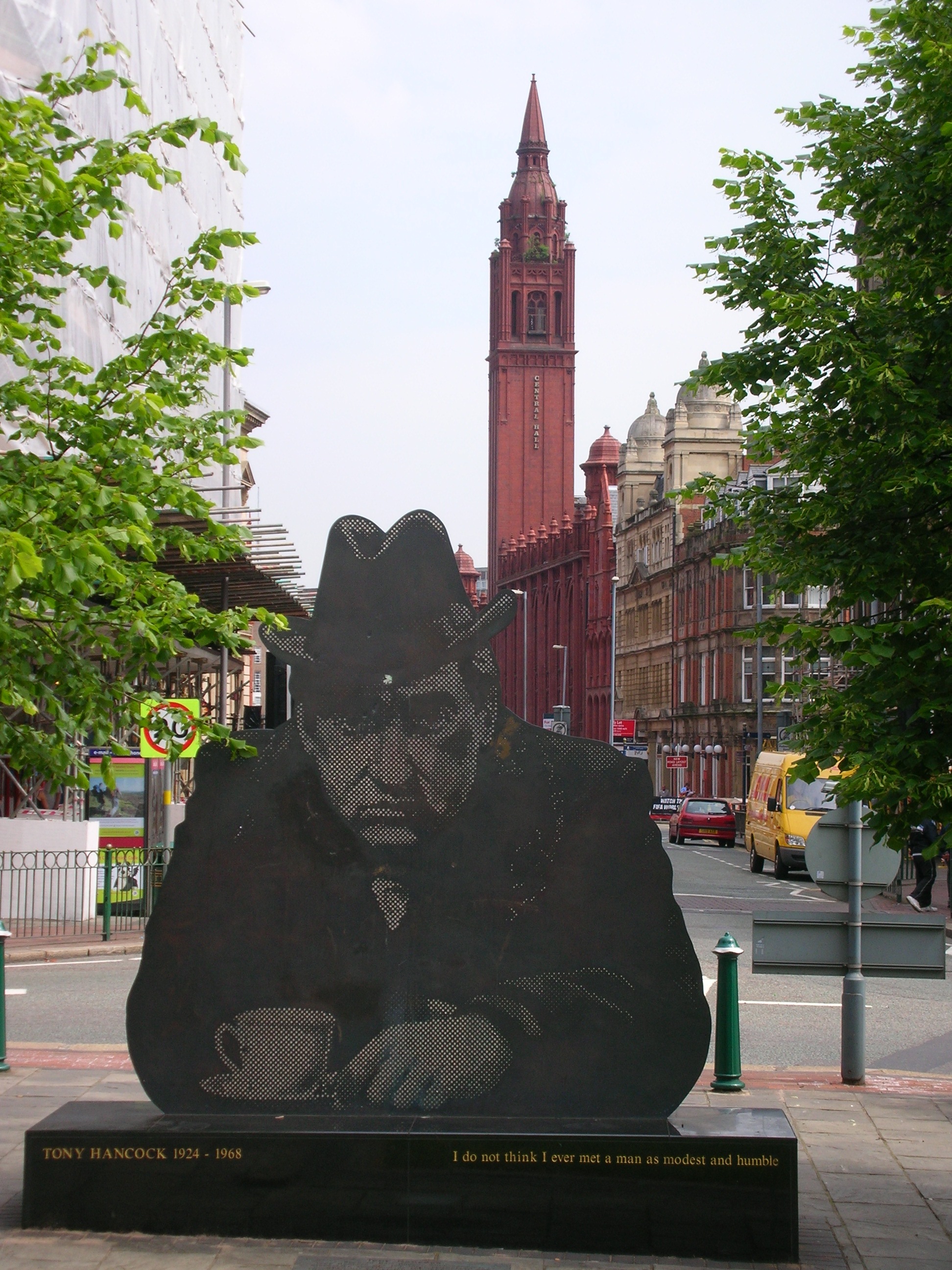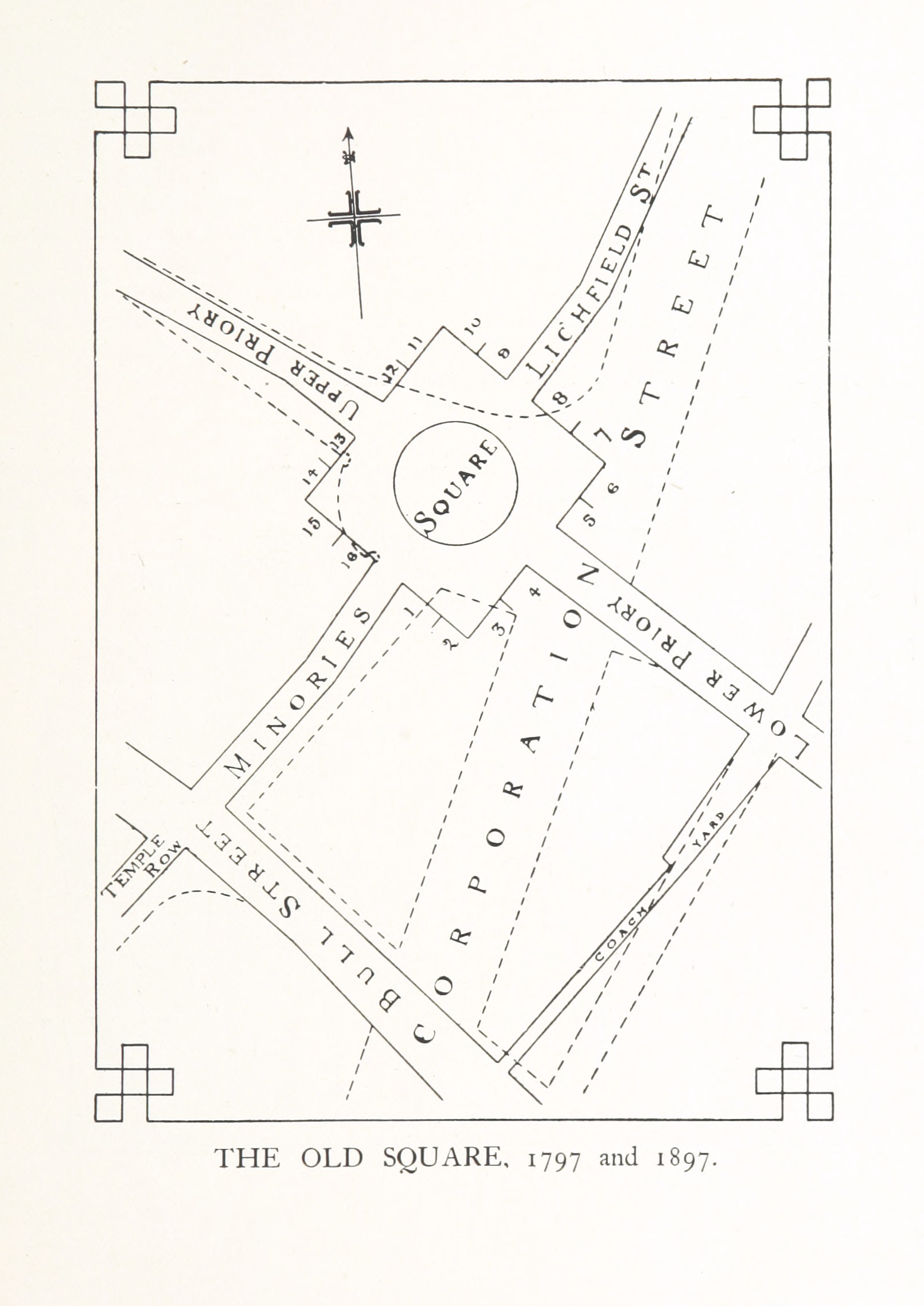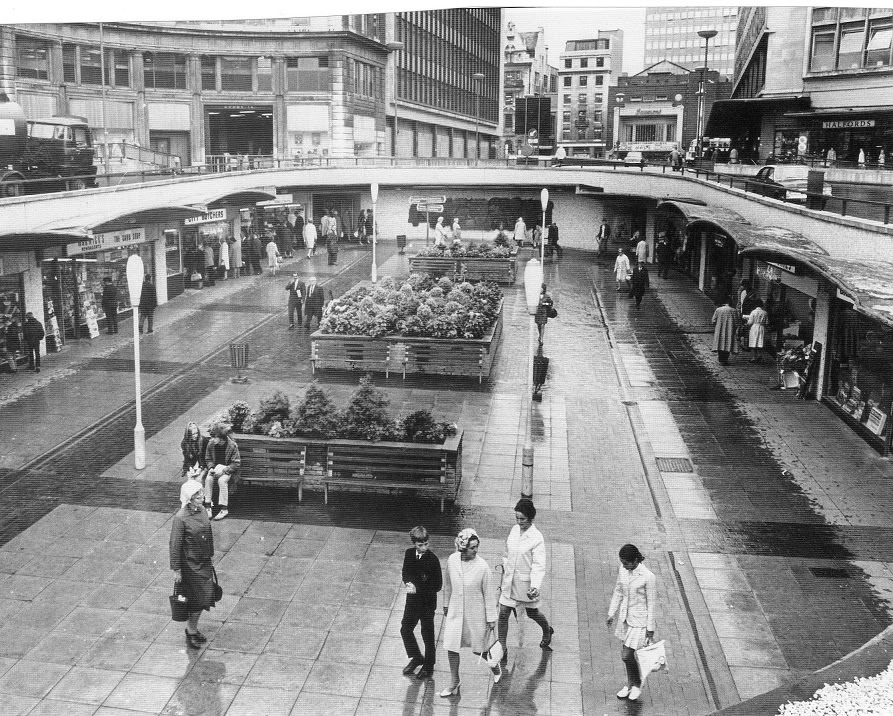Old Square, Birmingham on:
[Wikipedia]
[Google]
[Amazon]
 Old Square is a
Old Square is a
 The square dates from 1713 when it was recorded as having 16 uniform two-storied houses with five-bayed fronts having angle pilasters, pedimented doorways, and dormer windows. It was created as the centrepiece to John Pemberton's Priory Estate. It was designed by William Westley who produced a print of the square's layout in 1732. From old conveyances, it is recorded that 20s. per yard frontage was paid for the site of some of the houses in the square and up to 40s. in Bull Street; the back plots, including the Friends' burial ground (once gardens to the front houses) being valued at 1s. to 2s. per yard. One of the corner houses, originally called "the Angle House", was popular in that it was sold in 1791 for £420, increasing to £970 in 1805. In 1843 the price increased £1,330 and in 1853, £2,515.
The square dates from 1713 when it was recorded as having 16 uniform two-storied houses with five-bayed fronts having angle pilasters, pedimented doorways, and dormer windows. It was created as the centrepiece to John Pemberton's Priory Estate. It was designed by William Westley who produced a print of the square's layout in 1732. From old conveyances, it is recorded that 20s. per yard frontage was paid for the site of some of the houses in the square and up to 40s. in Bull Street; the back plots, including the Friends' burial ground (once gardens to the front houses) being valued at 1s. to 2s. per yard. One of the corner houses, originally called "the Angle House", was popular in that it was sold in 1791 for £420, increasing to £970 in 1805. In 1843 the price increased £1,330 and in 1853, £2,515.
 The centre of the square itself was closed off with iron railings with several pedestrian paths. Over time it became neglected and in 1832 it was the scene of a public demonstration. The stones there were used as missiles by the crowd during the parliamentary elections of that year.
The trees and railings were removed during 1836 and 1837 as a result of many accidents occurring there due to the roadways being narrow and dangerous. Following this, the
The centre of the square itself was closed off with iron railings with several pedestrian paths. Over time it became neglected and in 1832 it was the scene of a public demonstration. The stones there were used as missiles by the crowd during the parliamentary elections of that year.
The trees and railings were removed during 1836 and 1837 as a result of many accidents occurring there due to the roadways being narrow and dangerous. Following this, the
 The square was to suffer a major demolition programme in 1882 to make way for the construction of Corporation Street. Buildings that were constructed as a result were of grand architecture, one of which was the Grand Theatre to the south of the square.
The square was to suffer a major demolition programme in 1882 to make way for the construction of Corporation Street. Buildings that were constructed as a result were of grand architecture, one of which was the Grand Theatre to the south of the square.
 During
During  The square was to become subject to more development during the post-war years when the land leases given to the builders of Corporation Street during the 1880s expired. This resulted in the demolition of many Victorian buildings. As one major part of the development of Old Square, Lower Priory to the south was converted into the Priory Queensway, which required the road to be widened and elevated. To do this, the Grand Theatre was demolished and an underground car park was constructed beneath. The Priory Queensway made it possible for the construction of
The square was to become subject to more development during the post-war years when the land leases given to the builders of Corporation Street during the 1880s expired. This resulted in the demolition of many Victorian buildings. As one major part of the development of Old Square, Lower Priory to the south was converted into the Priory Queensway, which required the road to be widened and elevated. To do this, the Grand Theatre was demolished and an underground car park was constructed beneath. The Priory Queensway made it possible for the construction of
Contents
Tony Hancock memorial British History Online Maps: 'Warwickshire: 014/05', Ordnance Survey 1:2,500: Epoch 1 (1890)Secular Architecture in BirminghamNurton Developments: Priory and Cannon HouseGrand Theatre
{{coord, 52.4822, N, 1.8944, W, type:landmark, display=title Squares in Birmingham, West Midlands
 Old Square is a
Old Square is a public square
A town square (or square, plaza, public square, city square, urban square, or ''piazza'') is an open public space, commonly found in the heart of a traditional town but not necessarily a true geometric square, used for community gatherings. ...
and road junction
A junction is where two or more roads meet.
History
Roads began as a means of linking locations of interest: towns, forts and geographic features such as river fords. Where roads met outside of an existing settlement, these junctions often led ...
in the Core area of Birmingham City Centre
Birmingham City Centre, also known as Central Birmingham and often known locally as town, is the central business district of Birmingham, England. Following the removal of the Inner Ring Road, the city centre is now defined as being the area wi ...
, England
England is a country that is part of the United Kingdom. It shares land borders with Wales to its west and Scotland to its north. The Irish Sea lies northwest and the Celtic Sea to the southwest. It is separated from continental Europe b ...
.
Prior to construction
The site of the square was formerly occupied the Priory of St Thomas of Canterbury, with The Minories, Upper Priory and Lower Priory being the original entrance roads to the hospital. The land is believed to have once been the highest point in Birmingham city centre leading to the construction of the priory. In 1536, the Priory was dissolved and the structures on site were demolished in 1547. The site remained as ruins for 150 years until it was purchased by John Pemberton in 1697. He further levelled the land for construction work to create his Priory estate.Redevelopment
 The square dates from 1713 when it was recorded as having 16 uniform two-storied houses with five-bayed fronts having angle pilasters, pedimented doorways, and dormer windows. It was created as the centrepiece to John Pemberton's Priory Estate. It was designed by William Westley who produced a print of the square's layout in 1732. From old conveyances, it is recorded that 20s. per yard frontage was paid for the site of some of the houses in the square and up to 40s. in Bull Street; the back plots, including the Friends' burial ground (once gardens to the front houses) being valued at 1s. to 2s. per yard. One of the corner houses, originally called "the Angle House", was popular in that it was sold in 1791 for £420, increasing to £970 in 1805. In 1843 the price increased £1,330 and in 1853, £2,515.
The square dates from 1713 when it was recorded as having 16 uniform two-storied houses with five-bayed fronts having angle pilasters, pedimented doorways, and dormer windows. It was created as the centrepiece to John Pemberton's Priory Estate. It was designed by William Westley who produced a print of the square's layout in 1732. From old conveyances, it is recorded that 20s. per yard frontage was paid for the site of some of the houses in the square and up to 40s. in Bull Street; the back plots, including the Friends' burial ground (once gardens to the front houses) being valued at 1s. to 2s. per yard. One of the corner houses, originally called "the Angle House", was popular in that it was sold in 1791 for £420, increasing to £970 in 1805. In 1843 the price increased £1,330 and in 1853, £2,515.
 The centre of the square itself was closed off with iron railings with several pedestrian paths. Over time it became neglected and in 1832 it was the scene of a public demonstration. The stones there were used as missiles by the crowd during the parliamentary elections of that year.
The trees and railings were removed during 1836 and 1837 as a result of many accidents occurring there due to the roadways being narrow and dangerous. Following this, the
The centre of the square itself was closed off with iron railings with several pedestrian paths. Over time it became neglected and in 1832 it was the scene of a public demonstration. The stones there were used as missiles by the crowd during the parliamentary elections of that year.
The trees and railings were removed during 1836 and 1837 as a result of many accidents occurring there due to the roadways being narrow and dangerous. Following this, the Birmingham Street Commissioners
The Birmingham Street Commissioners were a local government body, created in Birmingham, England in 1769, with powers to manage matters such as streets, markets, and policing. Subsequent Improvement Acts of 1773, 1801, and 1812 gave increased power ...
widened the roads.
Construction of Corporation Street
 The square was to suffer a major demolition programme in 1882 to make way for the construction of Corporation Street. Buildings that were constructed as a result were of grand architecture, one of which was the Grand Theatre to the south of the square.
The square was to suffer a major demolition programme in 1882 to make way for the construction of Corporation Street. Buildings that were constructed as a result were of grand architecture, one of which was the Grand Theatre to the south of the square. Lewis's
Lewis's was a chain of British department stores that operated from 1856 to 2010. The owners of Lewis's have gone into administration many times over the years, including 1991. The first store, which opened in Liverpool city centre, became ...
Department store was constructed at the western end to replace Berlin House and to build over the Minories in 1885 following personal persuasion from Joseph Chamberlain
Joseph Chamberlain (8 July 1836 – 2 July 1914) was a British statesman who was first a radical Liberal, then a Liberal Unionist after opposing home rule for Ireland, and eventually served as a leading imperialist in coalition with the C ...
.
During the Victorian era
In the history of the United Kingdom and the British Empire, the Victorian era was the period of Queen Victoria's reign, from 20 June 1837 until her death on 22 January 1901. The era followed the Georgian period and preceded the Edwardia ...
, the square became a tram
A tram (called a streetcar or trolley in North America) is a rail vehicle that travels on tramway tracks on public urban streets; some include segments on segregated right-of-way. The tramlines or networks operated as public transport are ...
junction for trams running along Corporation Street and those coming from Upper Priory.
World War II and postwar years
 During
During World War II
World War II or the Second World War, often abbreviated as WWII or WW2, was a world war that lasted from 1939 to 1945. It involved the vast majority of the world's countries—including all of the great powers—forming two opposing ...
, a hole was dug next to Lewis's Department Store and above it, a bomb shelter was built. The shelter did not suffer any damage however nearby areas along Corporation Street did suffer direct hits.
 The square was to become subject to more development during the post-war years when the land leases given to the builders of Corporation Street during the 1880s expired. This resulted in the demolition of many Victorian buildings. As one major part of the development of Old Square, Lower Priory to the south was converted into the Priory Queensway, which required the road to be widened and elevated. To do this, the Grand Theatre was demolished and an underground car park was constructed beneath. The Priory Queensway made it possible for the construction of
The square was to become subject to more development during the post-war years when the land leases given to the builders of Corporation Street during the 1880s expired. This resulted in the demolition of many Victorian buildings. As one major part of the development of Old Square, Lower Priory to the south was converted into the Priory Queensway, which required the road to be widened and elevated. To do this, the Grand Theatre was demolished and an underground car park was constructed beneath. The Priory Queensway made it possible for the construction of Priory Square
A priory is a monastery of men or women under religious vows that is headed by a prior or prioress. Priories may be houses of mendicant friars or nuns (such as the Dominicans, Augustinians, Franciscans, and Carmelites), or monasteries of monk ...
by Sir Frederick Gibberd
Sir Frederick Ernest Gibberd (7 January 1908 – 9 January 1984) was an English architect, town planner and landscape designer. He is particularly known for his work in Harlow, Essex, and for the BISF house, a design for a prefabricated council ...
in the southwestern corner of the square. In the southeast, another development to complement the new shopping centre was constructed. Pedestrians were relegated to subterranean subways, although these converged in an uncovered area, but below road level.
Recent history
In the early 2000s, Old Square was significantly redeveloped, to raise pedestrian routes through the square to the surface. As part of the development, the Priory Queensway was reconstructed as a sloping road following the gradient of the Birmingham city ridge as a result of the demolition of Masshouse Circus. In 2006, refurbishment work on Cannon House to the northeast of the square commenced to convert it into Grade Aoffice
An office is a space where an organization's employees perform administrative work in order to support and realize objects and goals of the organization. The word "office" may also denote a position within an organization with specific du ...
space. The development by Nurton Developments, who acquired the building in June 2004, also transformed the exterior.
Proposed future work to the square includes the redevelopment of Priory Square to create Martineau Galleries
Martineau Galleries is a proposed mixed-use development for Birmingham, England which was shelved in 2009 but re-approved in 2020. It was to connect the Eastside to the city centre core, a major retail area.
History
Pre-1960s development
...
by the Birmingham Alliance.
In the centre of Old Square is a memorial dedicated to Tony Hancock
Anthony John Hancock (12 May 1924 – 25 June 1968) was an English comedian and actor.
High-profile during the 1950s and early 1960s, he had a major success with his BBC series ''Hancock's Half Hour'', first broadcast on radio from 1954, ...
, who was born in the Hall Green
Hall Green is an area in southeast Birmingham, England, synonymous with the B28 postcode. It is also a council constituency, managed by its own district committee. Historically it lay within the county of Worcestershire.
Politics
Hall Green i ...
area of the city. The memorial, by Bruce Williams, was unveiled by Sir Harry Secombe
Sir Harold Donald Secombe (8 September 1921 – 11 April 2001) was a Welsh comedian, actor, singer and television presenter. Secombe was a member of the British radio comedy programme ''The Goon Show'' (1951–1960), playing many characters, m ...
on 13 May 1996. The memorial was originally intended to be placed on New Street but a temporary site on the Corporation Street edge of the square was found (at the time, it stood opposite a Blood Donor clinic, in a nod to Hancock's well-known sketch). The statue was relocated to the centre of Old Square after it was unveiled. An earlier public sculpture in Old Square is a mural named ''Old Square'' sculpted by Kenneth Budd
Kenneth George Budd (16 October 1925 – 21 January 1995) was an English mural artist, known for his mosaics and work in other materials. His company, Kenneth Budd and Associates was based in Penge, south London.
Budd was born in Fulham, ...
in 1967. The mural was commissioned by the Public Works Department of Birmingham City Council and was paid for from the Capital Account. It was unveiled on 21 April 1967 by Alderman C.V. Simpson, chairman of the Public Works Department. The mural depicts the history of Old Square from the priory onwards.
References
*''Online Planning Application - Number C/07564/05/OUT'', Birmingham Alliance. Submitted 06/12/2005 toBirmingham City Council
Birmingham City Council is the local government body responsible for the governance of the City of Birmingham in England, which has been a metropolitan district since 1974. It is the most populated local council area in the United Kingdom ...
for Martineau Galleries.
*
*
*''Memorials of the Old Square, Birmingham'', 1897Contents
Tony Hancock memorial
{{coord, 52.4822, N, 1.8944, W, type:landmark, display=title Squares in Birmingham, West Midlands